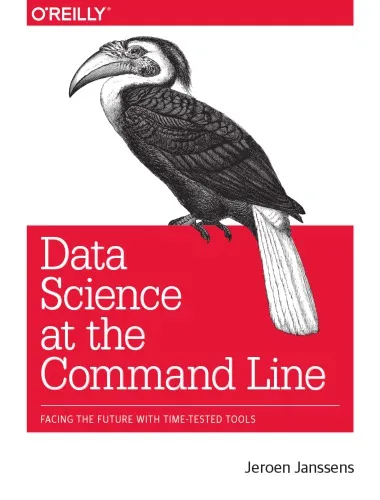Data science at the command line facing the future with time-tested tools
4.5
بر اساس نظر کاربران

شما میتونید سوالاتتون در باره کتاب رو از هوش مصنوعیش بعد از ورود بپرسید
هر دانلود یا پرسش از هوش مصنوعی 2 امتیاز لازم دارد، برای بدست آوردن امتیاز رایگان، به صفحه ی راهنمای امتیازات سر بزنید و یک سری کار ارزشمند انجام بدینمعرفی کامل کتاب "Data Science at the Command Line: Facing the Future with Time-Tested Tools"
کتاب Data Science at the Command Line نوشته Jeroen Janssens، به دستآوردی بینظیر در حوزه علم داده تعلق دارد. این کتاب، رویکردی مدرن به استفاده از ابزارهای سنتی خط فرمان (Command Line) ارائه میدهد و به علم دادهکاران کمک میکند تا تکنیکهای قدرتمندی برای کارایی بالا و سادهسازی وظایف روزانهشان بیاموزند.
خلاصهای دقیق از کتاب
این کتاب برای کسانی نوشته شده است که میخواهند از قابلیتهای خط فرمان برای بهبود روند کاری خود در علم داده بهره ببرند. نویسنده تاکید میکند که ابزارهای خط فرمان نه تنها برای وظایف ابتدایی بلکه برای انجام تحلیلهای پیچیده و حتی در machine learning بسیار موثر هستند. این کتاب شامل توضیحات دقیق درباره نصب و کار با ابزارهای معروف خط فرمان مانند awk، jq، csvkit، xsv و دیگر ابزارهاست. علاوه بر این، نویسنده نشان میدهد که چگونه میتوان این ابزارها را در کنار زبانهایی مانند Python و R استفاده کرد.
قسمتهای مختلف کتاب به گونهای طراحی شدهاند که تجربهای عملی و گام به گام را برای خواننده ایجاد کند. با بهرهگیری از آموزشهای این کتاب، میتوانید دادهها را تمیز کنید (data cleaning)، آنها را به راحتی تغییر دهید (data transformation)، تجزیه و تحلیلهای پیچیده انجام دهید (data analysis) و مهمتر از همه، قدرت کلی خط فرمان را در علم داده بشناسید.
نکات کلیدی از کتاب
- استفاده از ابزارهایی که نیاز به نصب کتابخانههای پیچیده ندارند اما قدرت بالایی دارند.
- توضیح مفاهیم
shell scriptingبرای اتوماسیون فرآیندهای مکرر و وقتگیر در علم داده. - معرفی بهترین ابزارهای خط فرمان برای کار با انواع مختلف داده (مثل
JSON،CSV، و متن ساده). - یکپارچهسازی اولیه ابزارهای خط فرمان با زبانهای برنامهنویسی مدرن.
- آموزش مفاهیم data pipelines برای کارایی بیشتر در مدیریت دادهها.
جملات معروف از کتاب
"The command line is like a Swiss army knife for data scientists."
"It’s not about replacing Python or R; it’s about complementing them."
"Once you master the command line, you hold the key to automating workflows and simplifying the most complex data tasks."
چرا این کتاب اهمیت دارد؟
با حجم عظیم دادهها و نیاز به تحلیل سریعتر و دقیقتر، ابزارهایی که میتوانند دادهها را بهطور مستقیم و بدون واسطه پردازش کنند، ارزشمندتر شدهاند. Data Science at the Command Line به علم دادهکاران این ابزارها را معرفی کرده و پلی بین ابزارهای سنتی و مدرن ایجاد میکند. این کتاب نشان میدهد که چرا یادگیری مهارتهای خط فرمان میتواند نه تنها زمانی که با دادهها کار میکنید، بلکه در طراحی سیستمها، اتوماسیون و حتی استفاده از منابع محاسباتی محدود، به شما کمک کند.
این اثر به دلیل ترکیب مفاهیم تئوری و عملی، منبعی ضروری برای دادهکاران مبتدی و حرفهای محسوب میشود. به بیان سادهتر، اگر به دنبال ابزاری قدرتمند، انعطافپذیر و ساده برای مدیریت و تحلیل دادهها هستید، این کتاب راهنمای کاملی ارائه میدهد.
Introduction to Data Science at the Command Line: Facing the Future with Time-Tested Tools
In a world that thrives on innovation and automation, data science has emerged as one of the most powerful forces driving change, discovery, and efficiency. Yet, amidst all the complex frameworks, expensive software, and cutting-edge technologies, there exists an often-overlooked treasure trove of tools that have withstood the test of time: the command line. My book, Data Science at the Command Line, explores the immense power and versatility available at your fingertips when embracing command-line tools for data science workflows.
Whether you're a seasoned analytics professional or a beginner stepping into the data science universe, this book equips you with the foundational tools, techniques, and mindset to conquer your data challenges. By combining traditional Unix-based tools with modern techniques, you’ll learn how to harness the command line to process, analyze, and visualize data efficiently, all while future-proofing your efforts in the ever-changing landscape of technology.
A Detailed Summary of the Book
The book introduces readers to the fundamentals of command-line usage, then gradually guides you through solving real-world data-related problems. We begin with basic concepts, such as navigating directories and manipulating files, and progress to advanced techniques like building sophisticated data pipelines, conducting exploratory data analysis, and integrating data science tools into broader workflows.
Along the way, you'll learn how to use popular command-line utilities like awk, sed, and jq. The book places special emphasis on freedom and flexibility, enabling you to mix and match tools effortlessly to meet the demands of your projects. The goal is to show how command-line tools can complement modern programming languages like Python and R, offering unique advantages such as speed, portability, and simplicity.
Recognizing the importance of the cloud and the growing need for automation at scale, later chapters delve into working with large-scale data sets, concurrency, and batch-processing techniques. There is also a strong focus on integrating the command line with machine learning frameworks and visualization tools, helping you bridge the gap between traditional data manipulation and state-of-the-art analytics methods.
Key Takeaways
- Learn how the command line simplifies repetitive tasks and accelerates your data workflows.
- Gain mastery over essential tools such as
grep,curl,awk,sed, and more. - Build robust data pipelines to process raw, structured, and semi-structured data efficiently.
- Explore techniques for data wrangling, transformation, and preparation using just a terminal.
- Integrate command-line utilities with languages like Python and R, maximizing your productivity.
- Future-proof your skills with tools that have endured decades of technological change.
Famous Quotes From the Book
"The command line is not antiquated; it is timeless. It has survived decades of technological upheaval because it offers unmatched efficiency, control, and precision."
"You don’t need a sprawling software toolkit to be a powerful data scientist. Sometimes, all you need is a terminal and a bit of ingenuity."
"The tools you build today with the command line will outlive trends, buzzwords, and the fleeting nature of hype cycles."
Why This Book Matters
In the fast-moving field of data science, technologies come and go, and staying relevant requires constant learning. This book is a reminder—and a demonstration—that innovation isn’t always about chasing the newest tools. Sometimes, the most powerful solutions are the simplest, and the command line is one of the most enduring examples.
Businesses and individuals worldwide are increasingly dealing with enormous amounts of data. However, relying entirely on closed-source applications or overly complex solutions can lead to higher costs, decreased flexibility, and dependency on tools that might not exist tomorrow. By learning to leverage the full potential of the command line, practitioners can achieve a level of independence and control in their workflows that’s second to none.
The lessons in this book aren’t just technical; they’re philosophical. At its core, Data Science at the Command Line is about empowering the individual, making data science accessible, and fostering a spirit of experimentation. Whether you're motivated by efficiency, curiosity, or a desire to hone your craftsmanship as a data scientist, this book offers something valuable for you.
دانلود رایگان مستقیم
شما میتونید سوالاتتون در باره کتاب رو از هوش مصنوعیش بعد از ورود بپرسید
دسترسی به کتابها از طریق پلتفرمهای قانونی و کتابخانههای عمومی نه تنها از حقوق نویسندگان و ناشران حمایت میکند، بلکه به پایداری فرهنگ کتابخوانی نیز کمک میرساند. پیش از دانلود، لحظهای به بررسی این گزینهها فکر کنید.
این کتاب رو در پلتفرم های دیگه ببینید
WorldCat به شما کمک میکنه تا کتاب ها رو در کتابخانه های سراسر دنیا پیدا کنید
امتیازها، نظرات تخصصی و صحبت ها درباره کتاب را در Goodreads ببینید
کتابهای کمیاب یا دست دوم را در AbeBooks پیدا کنید و بخرید


